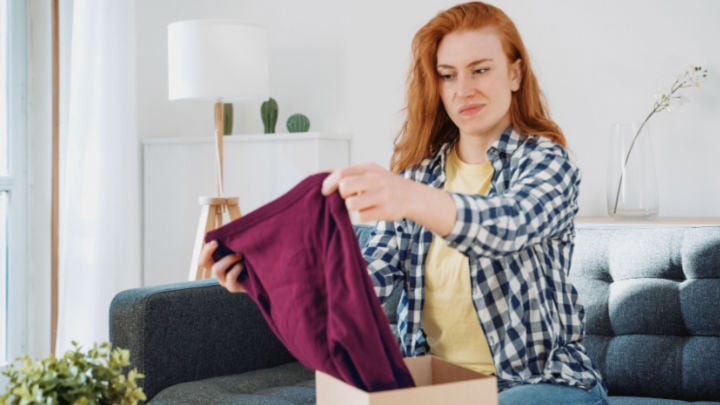SEO Tips for E-commerce: Improve Your Online Shop's Ranking in Google
SEO is an important tool for e-commerce businesses to bring in new customers. Here are the best tips for your online shop to rank higher in Google.

Serial returners can be a real problem in the world of e-commerce. This is especially true in the fashion industry, where the act of finding clothes that fit can best be done when holding the physical product. Even with returns factored into your annual budgets, you should still do all you can to minimise them.
Naturally, customers should have the right to return products. And offering free returns can also be used to entice shoppers to buy from you. It minimises both their costs and their risks. However, this can naturally cost you, as the online shop owner, lots of money.
Minimising the issue will not only reduce your costs as a retailer, but it is also better for the environment! Whatever reason you may have for wanting to reduce returns and make "serial returners" more likely to keep their products, we've got some tips for you today!
A serial returner is a shopper who buy many things from an online shop, but also returns a lot of products. This is often already planned by the shopper before the purchase is completed. In the fashion industry, shoppers may buy the same item in different sizes with the intent of only keeping the item that fits best and returning the rest.
These kinds of shoppers are making your return rates sky-rocket. Some people also refer to them as “wardrobers”, but whatever name you give them, they could be costing your shop thousands of pounds per year.
Can you completely avoid serial returners? Probably not, but you can take some measures to control it.
Before we figure out why serial returners do what they do, let’s look at some statistics to give you an idea of the scope of the problem.
There are some fascinating numbers that give us insights into what the current situation looks like as well as the attitudes of both shop owners and consumers towards returns.
First off, let’s look at some general statistics regarding returns for online purchases.
Source: Statista
This first statistic basically confirms what was mentioned earlier. Many products are returned online because they don’t fit (66%).
This supports why serial returners do what they do. Experienced online shoppers know there is a good chance their clothes won’t fit. So, rather than ordering one size of a particular item, they will order two or three sizes knowing full well that the size they think should fit them might not. This is essentially a time saving technique, which is encouraged by offers of free returns.
Source: Statista
According to these numbers, an alarming number of younger online shoppers are returning products. In fact, the 18-24 age group is the one responsible for the highest percentage of returns in each of the markets analyzed here.
Considering that young people are the most comfortable shopping online and also quit vocal about sustainability and going green, it’s a bit surprising to see that they are most likely to return products. However, it should be noted that these numbers don’t account for the kind of return (i.e. in-store vs by post).
Source: Statista
Speaking of in-store returns, this chart shows us that consumers are very willing to return products in store. In fact, if they know that this is a possibility, it actually has a positive impact on their decision to buy.
Let’s look at some numbers regarding online shops and their return policies.
Source: Statista
As we can see, free returns has been an issue for online shop owners for a few years. The number of online retailers in the UK that offer free returns has dropped dramatically from 2019 to 2020.
Surprisingly though, slightly more retailers offered free returns by collection (i.e. from the customer’s home).
Source: Statista
To support the previous statistic, we see that it is quite popular for online retailers in the UK to offer returns in store.
It’s also interesting to note the increase in “drop-off” options, including parcel shop drop-off, Collect + drop-off, and Locker drop-offs among others.
Let’s have a look at some consumer attitudes towards returns.
Source: Statista
This statistic is quite interesting. It actually shows us that roughly half of consumers in the UK think that they, the consumers, should be responsible for paying for returns. Men tend to agree with this more than woman, but the fact remains that consumers don’t necessarily feel entitled to free returns.
Source: Statista
When German consumers were asked about the importance of sustainable order fulfilment, 83% of them said that order returns policy was either important or very important.
This goes to show that consumers seem to be aware that returns have an impact on the environment and feel that the issue needs addressing.

Shutterstock/Syda Productions
Now that we know how much of a problem it actually is, we can ask ourselves why these “serial returners” are sending so many items back. Well, some of the reasons we’ve touched on are fairly obvious: the size doesn’t fit as expected. Perhaps, the fabric looked different in the images. Sometimes, the wrong item was simply shipped. These are all fairly legitimate reasons for returning products, especially considering when those purchases are made online. No argument here, right?
Some of the other reasons for returned items, however, may be a bit less sincere or justified. Some people actually buy clothes with the intent of wearing the item once (keeping the tags on), and then returning it.
This happens so much that there is a new expression for this: wardrobing. That is the cute name for these kinds of “shoppers”. Others simply call them fraudulent returners. Though this definitely happens mostly with clothing, it is known to happen with other products as well, such as tools, outdoor gear, and electronics.
Other consumers that purchase clothes with the intent of returning it do so because of sizing issues, as we’ve mentioned earlier. They will often buy the same article of clothing in multiple sizes in order to find the one that fits best and then go on to return the items that don’t fit.
Although many serial returners don’t act as sinisterly as the wardrobers do, it still ends up costing retailers a lot of money. For all those returners who actually want to keep your clothes, whether they’re serial returners or not, you’ll want to take actions to minimise these returns.

"Don't worry, Timmy. If those shoes don't fit, we'll just send them back! I love free returns!" (Source: Shutterstock/greenland)
When speaking about returned items, there is an entire process that happens that we don’t really think about. And every step of the process costs retailers money. For example, customers today have come to expect not only free shipping, but free returns as well. That means that retailers have a high probability of paying for two shipments.
On top of that, some retailers prepare special packaging in their deliveries anticipating that certain products may be returned. Special packaging naturally costs more than a standard box.
Recommended reading:
The Relationship Between Unboxing Experiences and Customer Retention
Once the product has been returned, it doesn’t just go back to the warehouse. These products are usually sent to companies that clean and repackage these goods so that they can be sold again.
All in all, the average cost for handling a return comes out to about £15. This, in turn, forces many retailers to increase the price of their products to balance out the costs of handling these returns.
There are a lot of things that can be done to minimise returns to your online shop. Some of them are happening on an industry scale while others can be implemented individually. Some of these ideas are working, but for the most part need to be tweaked.

Shutterstock/tommaso79
Just like any problem on the internet, a solution is out there, but sometimes they take time (e.g. Netflix and Spotify helping with illegal downloads). Let’s have a look at some of these strategies.
For starters, raising prices on products to counteract the costs of returns obviously raises its own problems. However, if free returns are really important to your business, you might have to reconsider your pricing strategies. You’ll obviously need to account for returns in your annual budgeting.
It can be tricky to find a price point that will compensate for a high number of returns while also not scaring away customers. Your best bet is to discourage returns in the first place.
This section will be particularly useful for clothing retailers.
Some retailers are trying to organise a standard international sizing system. Anyone who has purchased things abroad has probably noticed that a large in one country isn’t necessarily the same size you would expect in another. Standardising this across the globe is obviously a huge challenge.
Some brands have tried adding questions and tools to their website in order to figure out people’s sizes, fashion tastes, etc. For example, tools exist that quiz customers on their measurements and fit-preferences (i.e. loose, average, tight, etc.) are also more common these days.
The risk here is prolonging (and possibly disturbing) the customer experience. Too many clicks or questions can significantly impact an online shop’s conversion rates.
Some brands also use the information from previous purchases to inform shoppers about how another product would fit them. This can work particularly well with repeat customers.
A rather simple solution could be to be transparent about the sizing as seen in your product images. Having plenty of product images is always an important factor for building trust and increasing conversions, but they can serve a really practical purpose when it comes to returns.
Adding information about the model’s height and weight along with the size they are wearing can help shoppers figure out what size would suit them. You might even want to consider showing multiple models. Alternatively, you could have a product chart that shows the exact measurements for each size.
You might not necessarily need to eliminate free returns. However, you might want to limit the duration of time that the customer has to qualify for one. Of course, you’ll need to stay up to date on your country’s return policies, but this is a strategy to consider. No matter what, you should be transparent about this directly on your website.
Last, but not least, displaying product reviews on your product page can help reduce returns. This won’t only address size issues, but it is a great way to show consumers what they can expect from a product in general.
Product reviews can bring a lot of advantages to your company, including SEO benefits. But from a consumer experience perspective, it gives your shop an element of transparency. Social proof can be a great to boost conversions, but it also helps reduce returns.
Many of us appreciate the convenience of shopping online, especially when it comes to clothes. Though retailers have to compete with each other to give their customers the best offers, consumers are finding new tactics to make shopping more convenient for them, leaving retailers to foot the bill when it comes to returns.
However, solutions exist to decrease these return rates, saving businesses money on handling returns, and saving consumers time from shopping. Don’t hesitate to experiment to see what works for you and your audience, and watch those return rates drop while simultaneously increasing confidence from your customers.
28/06/22SEO is an important tool for e-commerce businesses to bring in new customers. Here are the best tips for your online shop to rank higher in Google.
Valentine's Day has grown in popularity across Europe. We're sharing some romantic statistics (redundant, right?) and look at 9 marketing tips for V-day.